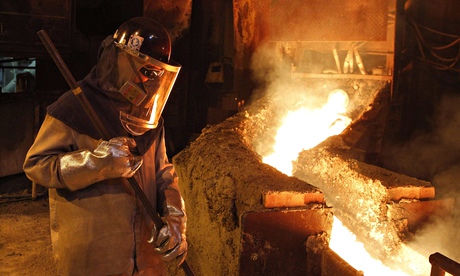
Copper prices, seen as a barometer of industrial demand around the world, plunged to a five-and-a-half low on Wednesday as fears grew over the health of the global economy.
Amid a wider commodities sell-off the metal was down more than 8% at one point at $5,353.25 (£3,531.38) a tonne – a level last seen during the depths of the financial crisis in July 2009.
Investors were panicked into selling after the World Bank raised fresh concerns about the health of the global economy, cutting its growth forecasts for this year and next and warning the eurozone economy could be facing permanent stagnation.
Copper is now in the midst of its longest run of losses for a year, and dragged other commodities lower. Lead fell to a 30-month low, nickel was down at an 11-month low, zinc and aluminium fell and spot iron ore prices were close to their lowest level in more than five years.
Analysts said it was an extension of the big oil sell-off that has cut prices of benchmark Brent crude by more than half since last summer against a backdrop of weak demand and rising supply. Brent was trading at just above $46 a barrely.
Jasper Lawler, market analyst at CMC Markets, said: “The World Bank downgrade and collapsing industrial metal prices such as copper just act to confirm global growth fears that plagued markets in 2014 and are continuing to do so in the New Year.
“Declining oil and copper prices reflect in part oversupply but also slower demand particularly from the likes of China, the world’s biggest buyer of commodities.”
China is crucial to the whole picture, accounting for about 45% of global demand for copper as the metal’s wide range of uses for wiring, piping and in general industry make it essential to an economy where infrastructure is expanding. Although China is still growing fast compared with advanced nations such as Britain and US, growth is nevertheless slowing and fears of a hard landing remain. Growth last year is expected to have been less than 7.5%, missing Beijing’s target for the first time since 1998.
Unlike oil, which is in plentiful supply, the supply of copper is considered relatively tight. Although analysts are predicting a small surplus of copper this year, they expect a deficit for 2016 suggesting the fall in the copper price is driven more by worries over global growth than any supply glut.
Daniel Morgan, analyst at UBS in Sydney, said: “The growth picture is worse now than it was six months ago. And given that’s Europe, Japan and China, for base metals that’s going to be a big deal.”
Also weighing on oil, copper and other commodity prices is a strong dollar. When the dollar is strong, the price of dollar-denominated commodities such as oil and copper tend to fall, because they are globally traded and are more expensive for holders of foreign currencies.
Iron ore prices are also very vulnerable to the outlook in China, which is the top consumer of the major ingredient to make steel. Sluggish demand for iron ore from Chinese steel producers, partly as construction activity slows in winter, has helped drive the price lower. Analysts at Citi slashed their average price forecasts for iron ore to $58 per tonne in 2014 and $62 in 2016, down from earlier forecasts of $65 for both years.
The falling oil price could turn out to be supportive of other commodities in the coming months if it boosts global activity as most economists predict. The World Bank said that while there would be winners and losers from the oil price fall, on balance it would be positive for global growth. For example, lower oil prices are feeding through to British petrol pumps, making it cheaper to run a car and putting more money in consumers’ pockets.
Analysts are divided on whether copper prices will go even lower. Max Layton, metals analyst at Goldman Sachs, said in all likelihood they will. He said the copper price is trying to find a new equilibrium in an environment of heightened demand uncertainty and cost deflation. “While this level is difficult to predict, we believe that the risks to prices and our forecasts are still heavily skewed to the downside,” he said, citing continued weakness in demand from China.
He added: “The outlook for 2015 for copper remains challenged by the following anticipated headwinds – further dollar strength, commodity price deflation, China’s shift to a new normal (tight credit, slowing growth), weakening copper intensive construction completions growth, and above trend supply growth.”
But Julian Jessop, chief global economist at Capital Economics, said concern over falling copper prices was overdone.
“The sharp ... fall in copper prices seems to have been driven by investor panic rather than a sudden deterioration in fundamentals and, as such, it could swiftly be reversed.
“Admittedly, copper’s reputation as a bellwether for the health of the global economy – and China in particular – means that it cannot be ignored. But the prices of most industrial metals have been weakening for several years and the latest moves do not mark a major change in the trends.”







